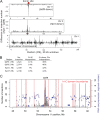The piggyBac transposon displays local and distant reintegration preferences and can cause mutations at noncanonical integration sites
- PMID: 23358416
- PMCID: PMC3624274
- DOI: 10.1128/MCB.00670-12
The piggyBac transposon displays local and distant reintegration preferences and can cause mutations at noncanonical integration sites
Abstract
The DNA transposon piggyBac is widely used as a tool in mammalian experimental systems for transgenesis, mutagenesis, and genome engineering. We have characterized genome-wide insertion site preferences of piggyBac by sequencing a large set of integration sites arising from transposition from two separate genomic loci and a plasmid donor in mouse embryonic stem cells. We found that piggyBac preferentially integrates locally to the excision site when mobilized from a chromosomal location and identified other nonlocal regions of the genome with elevated insertion frequencies. piggyBac insertions were associated with expressed genes and markers of open chromatin structure and were excluded from heterochromatin. At the nucleotide level, piggyBac prefers to insert into TA-rich regions within a broader GC-rich context. We also found that piggyBac can insert into sites other than its known TTAA insertion site at a low frequency (2%). Such insertions introduce mismatches that are repaired with signatures of host cell repair pathways. Transposons could be mobilized from plasmids with the observed noncanonical flanking regions, indicating that piggyBac could generate point mutations in the genome.
Figures










References
-
- Ivics Z, Hackett PB, Plasterk RH, Izsvàk Z. 1997. Molecular reconstruction of Sleeping Beauty, a Tc1-like transposon from fish, and its transposition in human cells. Cell 91:501–510 - PubMed
-
- Fraser MJ, Ciszczon T, Elick T, Bauser C. 1996. Precise excision of TTAA-specific lepidopteran transposons piggyBac (IFP2) and tagalong (TFP3) from the baculovirus genome in cell lines from two species of Lepidoptera. Insect Mol. Biol. 5:141–151 - PubMed
-
- Ding S, Wu X, Li G, Han M, Zhuang Y, Xu T. 2005. Efficient transposition of the piggyBac (PB) transposon in mammalian cells and mice. Cell 122:473–483 - PubMed
-
- Li MA, Turner DJ, Ning Z, Yusa K, Liang Q, Eckert S, Rad L, Fitzgerald TW, Craig NL, Bradley A. 2011. Mobilization of giant piggyBac transposons in the mouse genome. Nucleic Acids Res. 39:e148 doi:10.1093/nar/gkr764 - DOI - PMC - PubMed
-
- Cadiñanos J, Bradley A. 2007. Generation of an inducible and optimized piggyBac transposon system. Nucleic Acids Res. 35:e87 doi:10.1093/nar/gkm446 - DOI - PMC - PubMed
Publication types
MeSH terms
Substances
Grants and funding
LinkOut - more resources
Full Text Sources
Other Literature Sources
Molecular Biology Databases
Miscellaneous
